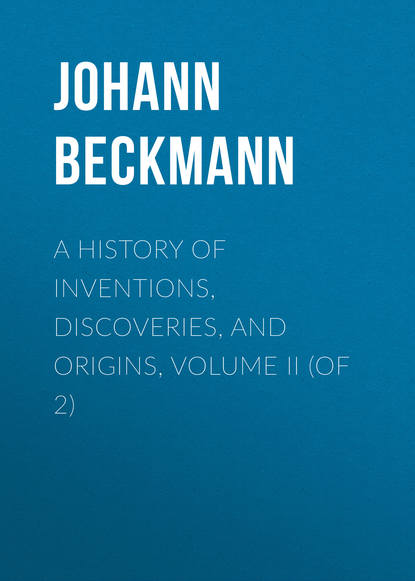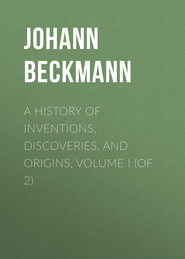По всем вопросам обращайтесь на: info@litportal.ru
(©) 2003-2024.
✖
A History of Inventions, Discoveries, and Origins, Volume II (of 2)
Настройки чтения
Размер шрифта
Высота строк
Поля
Von Stetten, Kunst-geschichte von Augsburg, p. 43.
1285
Le Mire, a Catholic clergyman, who was born in 1598, and died in 1640, wrote a work De Scriptoribus Ecclesiasticis Sæculi xvi., which is printed in Fabricii Bibliotheca Ecclesiastica, Hamburgi 1718, fol. The passage to which I allude may be found p. 232; but perhaps 1564 has been given in Fabricius instead of 1554 by an error of the press.
1286
Labbe Bibliotheca Bibliothecarum, Lips. 1682, 12mo, p. 112.
1287
Hist. Lit. i. p. 203.
1288
Conspectus Reip. Litter, c. vi. § 2, p. 316.
1289
[The earliest known catalogue of English printed books on sale by a London bookseller, was published in 1595, by Andrew Maunsell, in folio. It was classed and consisted of two parts; the first containing Divinity, the second the Arts and Sciences; a third, containing History and Polite Literature, was intended but never published.]
1290
Frankf. 1765, 4to, p. 500.
1291
[Bücher Lexicon; a Catalogue of books printed in Europe, to 1750; with supplements to 1758, 8 parts in 4 vols. folio. A very elaborate compilation, in which the title, place of publication, name of publisher, date, size, number of sheets, and publication price, of all the books known at the time, are given, including even those printed as early as 1462. It mentions however a great many books which never existed.]
1292
Francofurti, ex offic. Joannis Saurii, impensis Petri Kopffii, 1602, 4to. The first part contains 563 pages, and the second 292.
1293
Looms of the first kind are seldom capable of weaving above sixteen pieces at one time: and very rarely eighteen, because the breadth necessary for that purpose would render them highly inconvenient. At a ribbon manufactory in the Milanese, there were some years ago, thirty looms of an excellent construction, each of which could weave twenty-four pieces together, so that sixty dozen of pieces were wove by the whole at the same time. See Voyage d’un François par Italie, i. p. 387. M. Escher, at Zurich, is said to have had a large ribbon-loom which was driven by water; but the traveller who saw the work, assured me that it was a machine for winding silk; and this seems to be probable, from the short account given of it by M. Andreæ, in his Briefen aus der Schweitz, pp. 49, 50.
1294
L’Hoggidi overo gl’ingegni non inferiori a’ passati.
1295
Page 7.
1296
Page 1191.
1297
Ibid. p. 2762.
1298
Von Lersner, Chronica der Stadt Frankfurt, ii. p. 566.
1299
Relatio Historica semestralis vernalis 1776, Art. 10.
1300
Hist. of Commerce.
1301
See this rescript in the Leipsiger Intelligenz-Blattern, 1765, p. 119.
1302
Penny Cyclopædia.
1303
A figure and description of the Hakenbüchse, the bock, the wheels and key, may be found in Daniel Histoire de la Milice Francaise. Amst. 1724, 2 vols. 4to, i. p. 334. At Dresden there is still preserved an old Büchse, on which, instead of a lock, there is a cock with a flint-stone placed opposite to the touch-hole, and this flint was rubbed with a file till it emitted a spark.
1304
[The musquet or musket is said to be a Spanish invention, and to have been first used at the battle of Pavia. They were so long and heavy as to require the support of a rest. In the time of Elizabeth and long after, the English musqueteer was very different from one at the present day. In addition to the musquet itself, he had to carry a flask of coarse powder for loading, and a touch-box of fine powder for priming; the bullets were contained in a leathern bag, the strings of which he had to draw to get at them; while in his hand was his burning match and musquet-rest.]
1305
De Civitate Noribergensi Commentat. 1697, 4to, p. 150: In chronico quodam MS. legitur: the fire-locks belonging to the shooting tubes were first found out at Nuremberg in 1517.
1306
Raetia das ist Beschreibung, &c. Zurich, 1616, fol. p. 152.
1307
Appenzeller Chronik. St. Gall, 1740, 8vo, p. 194.
1308
This kind of stone is not everywhere used for this purpose. In the Tyrol, for example, the hardest ferruginous granite, which consists of corneous, partly irregular and partly polyedral, pieces, is employed as flints, which therefore are called Tyrol flints. In other places, jasper, such as that found in great abundance in Turkey, is formed by grinding, and used in the same manner.
1309






